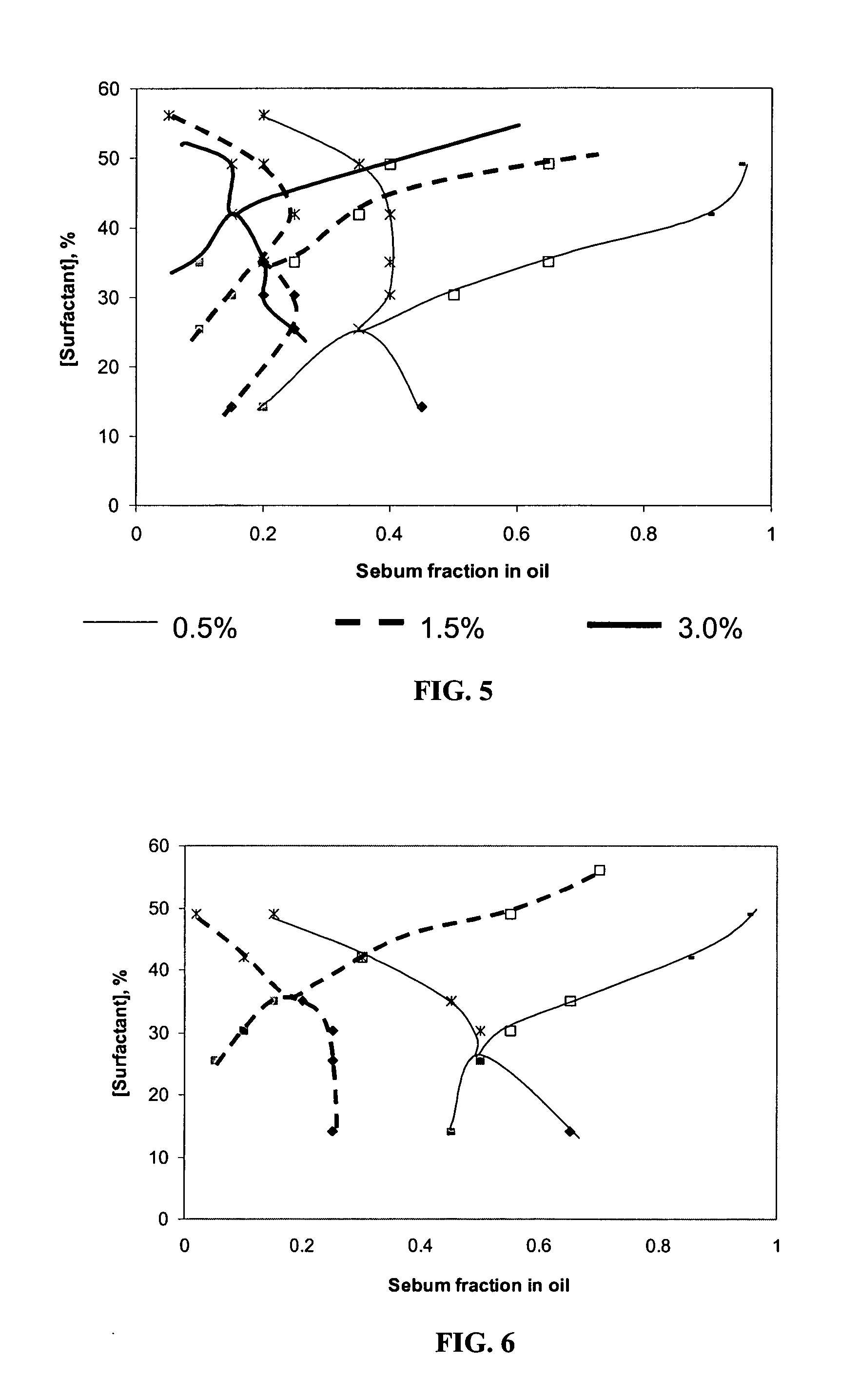Alcohol-free microemulsion composition
a technology of microemulsion and alcohol, which is applied in the direction of pharmaceutical active ingredients, hair cosmetics, toilet preparations, etc., can solve the problems of difficult to achieve microemulsion of larger amphiphilic oils such as triglycerides, unattractive flakes on the skin, and toxic or irritating use of alcohols, etc., to achieve superior sebum removal, improve the time it takes for sebum to break through makeup, and improve the effect of cleansing
- Summary
- Abstract
- Description
- Claims
- Application Information
AI Technical Summary
Benefits of technology
Problems solved by technology
Method used
Image
Examples
example 1
Experimental Procedures
[0083] The inventors have developed compositions comprising alcohol-free microemulsions and methods for their use. The following includes non-limiting materials and methods used in one aspect of the present invention. It will be appreciated by a person of ordinary skill in the art that the materials used in the following examples can be substituted, added to, or subtracted from the compositions of the present invention. Additionally, the methods used to determine the effectiveness of the compositions of the present invention are non-limiting aspects, and it is contemplated that other methods known to those of ordinary skill in the art can be used.
[0084] Materials: The following materials were obtained from Aldrich (Milwaukee, WI) at the concentrations shown and were used without further purification: sorbitan monooleate (Span 80, 99%), squalene (98%), squalane (99%), isopropyl myristate (IPM, 98%), ethyl laurate (99%), and sodium chloride (99%). Sodium dioct...
example 2
EACN of Co-Oils and Salinity
[0088] Formulating microemulsions requires the combination of variables that will provide a middle phase microemulsion. Salager et al. (1979) proposed a semi empirical equation that relates the different formulation variables:
Ln(S*)=k(EACN)+f(A)−σ+αTΔT
Where S* is an optimum salinity, or electrolyte concentration; k is a constant, normally, between 0.1 to 0.17, and EACN is the equivalent alkane carbon number for nonlinear hydrocarbon (e.g. triglycerides). Although preferred salinity concentrations may exist, the inventors contemplate that salinity levels can and will vary. For example, a person of ordinary skill in the art will recognize that salinity levels may vary depending on the desired effects of a given product, protocol, or individual characteristics of a user of the product. For linear hydrocarbon, alkane carbon number (ACN) is applied. The EACN is estimated based on the optimum salinity obtained in the inventors' formulation studies. The high...
example 3
Effect of Sebum Fraction in Oil and Surfactant Concentrations on Phase Diagram
[0092] Microemulsion phase transition: A Fish diagram for the system with squalene as co-oil at 0.5% NaCl is shown in FIG. 3. The fish tail is observed in the high concentration regime whereas the fish body appears in the low concentration regime. A surfactant concentration 14.19% wt was studied. As discussed throughout this document, however, the surfactant concentration can be varied. At lower surfactant concentrations, slow phase separation kinetics made it difficult to map out the three phase region. The surfactant concentration and the sebum fraction of oil at which the body and tail of the fish meet are denoted by “C” and “F”, respectively. The concentration C for this system, approximately, is 25% wt. surfactant concentration at the fraction F of 0.4, as summarized in Table 4.
TABLE 4Concentration (C) and sebum fraction in oil (F) in a non-limiting Type IVmicroemulsion[NaCl], %CFOil0.50%1.50%3.00%...
PUM
| Property | Measurement | Unit |
|---|---|---|
| size | aaaaa | aaaaa |
| size | aaaaa | aaaaa |
| particle size | aaaaa | aaaaa |
Abstract
Description
Claims
Application Information
 Login to View More
Login to View More - R&D
- Intellectual Property
- Life Sciences
- Materials
- Tech Scout
- Unparalleled Data Quality
- Higher Quality Content
- 60% Fewer Hallucinations
Browse by: Latest US Patents, China's latest patents, Technical Efficacy Thesaurus, Application Domain, Technology Topic, Popular Technical Reports.
© 2025 PatSnap. All rights reserved.Legal|Privacy policy|Modern Slavery Act Transparency Statement|Sitemap|About US| Contact US: help@patsnap.com



